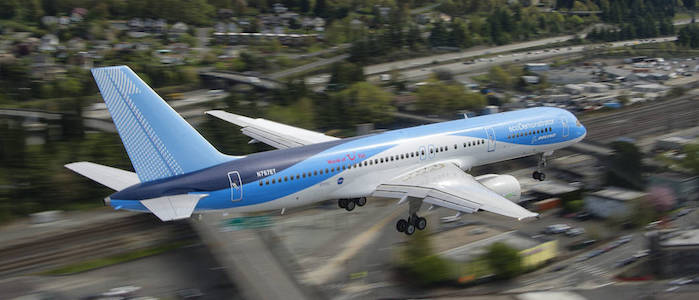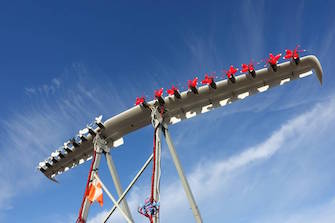The theme of Earth Day 2015, “It’s our turn to lead,” has us looking around at our nation’s research leaders to see where any of our governmental agencies are helping to lead the charge in environmentally friendly innovation. Over the past year, a conspicuous amount of aviation invention has come from NASA, the U.S. government’s federal aerospace and aeronautics research agency. A couple of notable green aviation projects conducted by NASA may very well contribute to carbon emission reductions for the entire global aviation industry, making what is perhaps the world’s most valuable form of transportation even more sustainable.
Aviation pollution pales in comparison to the amount of carbon released into the atmosphere by other sources. About 12 percent of transportation carbon emission pollution in the United States can be attributable to air transportation; by contrast, road travel accounts for 74 percent of U.S. transportation carbon emissions. Other pollutants emitted into the atmosphere from air travel include nitrous oxides, or NOx, which contribute to the production of ozone. Ozone in the upper atmosphere protects people from ultraviolet radiation, but producing ozone near ground-level or in the upper atmosphere can contribute to respiratory diseases. Past studies at Chicago’s Midway Airport and London’s Heathrow Airport showed that air travel contributes a great deal to ground-level NOx amounts, up to 35 percent of atmospheric NOx levels near the ground in some cases.
Producing more sustainable air travel is important because of the value of aviation transportation to stakeholders all over the world. A fact sheet put together by the aviation industry organization Air Transport Action Group (linked above and here) reports that the aviation industry itself employs 8.7 million people worldwide while supporting about 58.1 million people whose living relies on aviation through related tourism or commodities distribution. Although aviation is responsible for only 0.5 percent of global trade shipments, those shipments account for 35 percent of the value of global shipping. If aviation were its own country, it would rank 21st overall in terms of gross domestic product. Along with environmental concerns, fuel prices account for one-third of the aviation industry’s total costs, so improving fuel efficiency and developing cheaper biofuels could lead to less expensive air travel worldwide.

In this photo taken from a chase plane, the Boeing ecoDemonstrator 757 flight test airplane –with NASA’s Active Flow Control technology installed on the tail — makes a final approach to King County Boeing Field in Seattle, Washington.
One area where NASA has been placing a fair amount of its research focus is in developing design features that allow for reductions in an aircraft’s weight and the amount of drag it creates. The aeronautical research agency has entered into a partnership with the Boeing Company (NYSE:BA) of Seattle, WA, to test a couple of fuel efficiency technologies on a special Boeing 757 model known as the ecoDemonstrator. One NASA project utilizing the ecoDemonstrator (pictured above) is the Environmentally Responsible Aviation (ERA) project, which explores the benefits and risks of new vehicle design concepts. On the Boeing ecoDemonstrator, NASA installed a series of 31 sweeping jet actuators which are capable of on-demand manipulation of airflow over the vertical tail of an aircraft. The use of the sweeping jets would provide the stability and directional control usually supplied by the aircraft’s vertical tail, allowing manufacturers to reduce the tail’s size and the overall drag of the aircraft. A separate ERA project involving the ecoDemonstrator will test the insect repellant properties of various repellents for an Insect Accretion and Mitigation study. Even a small bug can disrupt the laminar flow of air over the leading edge of a wing, increasing drag and reducing fuel efficiency by as much as six percent. The Insect Accretion and Mitigation study will take place between April 27th and May 15th near the area of Shreveport, LA.
With the number of various aviation fuel efficiency projects being pursued by NASA currently, even small gains per project can add up for the aviation industry, which has committed to stabilizing its carbon emissions in the coming years. Another NASA ERA project pursued in cooperation with the aviation giant Boeing involves the testing of a product known as Pultruded Rod Stitched Efficient Unitized Structure (PRSEUS). PRSEUS is a low-weight, damage-tolerant composite material that would allow aircraft manufacturers to create larger size components, reducing the number of fasteners required to secure an aircraft’s body and reducing the aircraft’s overall weight. Researchers believe that the PRSEUS concept material could achieve a 25 percent weight reduction in aircraft composite when compared with current materials.
Biofuel concepts have been discussed for every form of transportation and air transport is no exception. NASA has supported a fair amount of research activities designed to determine whether biofuels and alternative fuels can reduce soot and carbon emissions of aircraft. NASA’s Armstrong Aircraft Operations Facility in Palmdale, CA, was the setting for the agency’s recent Alternative Fuel Effects on Contrails and Cruise Emissions (ACCESS II) tests. This study, a follow-up to biofuel flight tests performed in 2013, found that soot emissions from a DC-8 aircraft were reduced by 50 percent when a biofuel blend was substituted in the place of jet fuel. To test the emissions, NASA operated three sampler aircrafts to analyze emissions trails at distances ranging from 300 feet to 20 miles, determining both emissions levels and the effect of the biofuel on contrail formation.

The experimental wing, which has 18 motors, is called the Hybrid-Electric Integrated Systems Testbed (HEIST), is mounted on a specially modified truck.
Of course, there’s no greater reduction in fuel emission that can be realized by the ability to remove fuel entirely from the aircraft propulsion equation. That may sound impossible but NASA is taking steps towards that concept as a reality by contributing to the Leading Edge Asynchronous Propeller Technology (LEAPtech) project. A goal of this project is to help the aviation industry transition to electrical propulsion systems over the next decade. This February marked the start of a project lasting several months that will perform ground testing of a wing section spanning 31 feet and composed of a carbon composite enclosing 18 motors powered by lithium ion batteries. The project has contributed to the development of an experimental aircraft wing designed in part by ESAero of Pismo Beach, CA, and Joby Aviation of Santa Cruz, CA.
A recent article published here on IPWatchdog discusses many of the research developments NASA is continuing to make in its quest for greater understanding of outer space. Taken together with these general aviation research and development projects, it’s clear to see that NASA aims to be a leader in aviation innovation at any level of airspace. As Earth Day 2014 draws to a close, it’s good to reflect upon a research agency that is taking some part to lead the charge in keeping our atmosphere clear of pollutants.

![[IPWatchdog Logo]](https://ipwatchdog.com/wp-content/themes/IPWatchdog%20-%202023/assets/images/temp/logo-small@2x.png)


![[Advertisement]](https://ipwatchdog.com/wp-content/uploads/2024/04/Patent-Litigation-Masters-2024-sidebar-early-bird-ends-Apr-21-last-chance-700x500-1.jpg)

![[Advertisement]](https://ipwatchdog.com/wp-content/uploads/2021/12/WEBINAR-336-x-280-px.png)
![[Advertisement]](https://ipwatchdog.com/wp-content/uploads/2021/12/2021-Patent-Practice-on-Demand-recorded-Feb-2021-336-x-280.jpg)
![[Advertisement]](https://ipwatchdog.com/wp-content/uploads/2021/12/Ad-4-The-Invent-Patent-System™.png)







Join the Discussion
No comments yet.